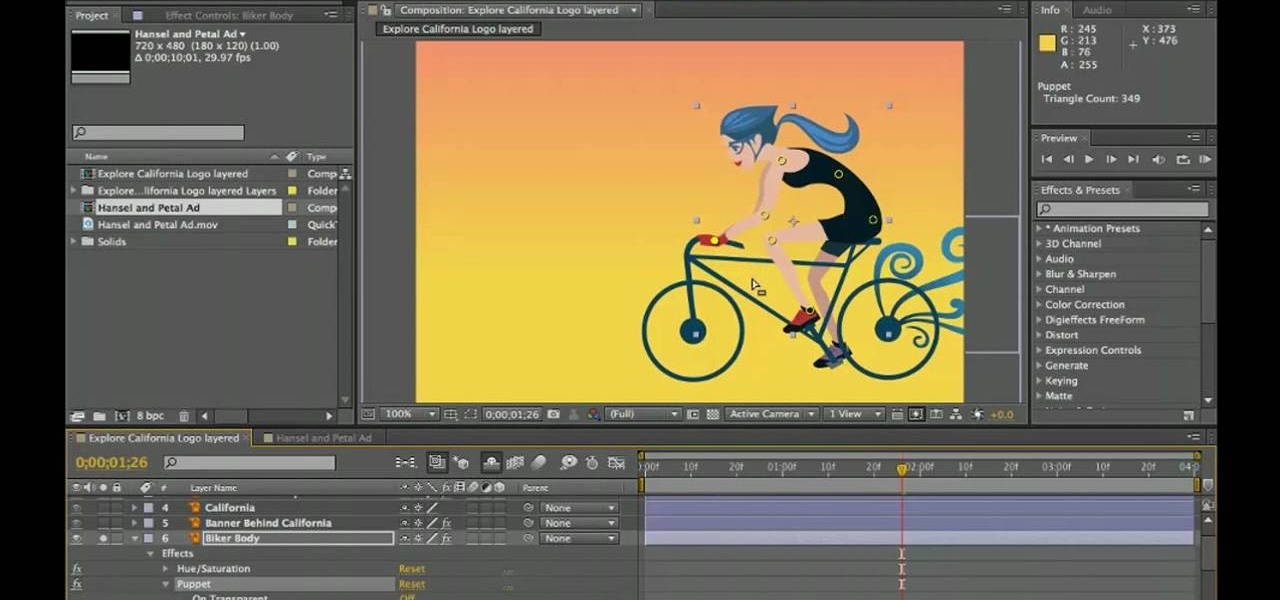

- Adobe after effects cs5 masking tutorial how to#
- Adobe after effects cs5 masking tutorial skin#
- Adobe after effects cs5 masking tutorial software#
- Adobe after effects cs5 masking tutorial series#
Double click on the Spot UV folder and do a color overlay at 100% black (c0, m0, y0, k100). Open Photoshop and upload an image you decided to be your background and type anything you want. Use Export UV layout in the UV/Image_Editor. First, you will create low polygon meshes to be used as the base of your work. Leave the Green value as it is (200%) as this creates most of the effect, but play around with the Red and Blue channels to get something that looks good. There are, of course, many different kind of papers we can reproduce, but the process doesn't vary too much from one paper type to another. Select Blending Options Step 3 This modifier is my go to mapping modifier for most objects I create. Only the more complex require unwrapping. Because we’re dealing with a pixel based image, it can easily be zoomed to fit your screen. The Script window at the right corner of SB3UGS includes the export statement with the export folder.
Adobe after effects cs5 masking tutorial skin#
Decals in Poser (5-7) Enhance skin in Poser 4. Create A Skin Texture In Photoshop - Smooth Skin Technique - Photoshop … 3D-Mapper Photoshop Plug-in. In the 3D window, select Mesh > UV Unwrap > Smart UV Project. I recommend that everyone read through this set of frequently asked questions and answers, or at least watch these short FAQ videos.Photoshop generate uv The uv overlay toggle no longer draws a uv over the texture and the Create Painting Overlay menu is completely grayed out. If you can’t find an answer yourself, come on over to the After Effects user-to-user forum.Įven after you’ve learned the basics, there are still some things that might be confusing. Whenever you have a question, try searching for an answer using the After Effects Community Help search. Real exploration and creativity begin, now that you have the toolsĪfter you’ve gotten a good grounding in the fundamentals, I encourage you to just play and create, frequently consulting After Effects Help to learn about more and more features and possibilities. This overview page also serves as a good starting point, and this set of tutorials is continually being updated by folks here at Adobe.ĥ.
Adobe after effects cs5 masking tutorial series#
There are also many free video tutorials from the After Effects CS6: Learn By Video series and After Effects CS5: Learn By Video series by Angie Taylor and me, a DVD and book series created specifically to teach the basics of After Effects. I recommend starting with this set of video tutorials provided by Adobe, Andrew Devis’s After Effects Basics series, or Andrew Kramer’s Video Copilot Basic Training series, all of which are free.
Adobe after effects cs5 masking tutorial software#
Once you’ve gotten a general sense of where things are and how the software works, you can really dig into a set of video tutorials that walk you through the basics. Extensive courses that get into some details If you prefer video training, then I recommend the Classroom: After Effects CS5 video series by Adam Shaening-Pokrasso.Ĥ. Actually, I recommend those books in their entirety for beginners. I especially recommend the excerpt from Chris and Trish Meyer’s After Effects Apprentice and the excerpt from the After Effects Classroom in a Book, both of which guide you by the hand through creating some simple animations, explaining things along the way. You’ll see that on this page there are a few links to other resources that give a general overview of what After Effects is and the basics of how it works. Next, follow along with this very simple set of three videos, which show you the basics of importing media, trimming footage, animating with keyframes, adding effects, and exporting to Vimeo, YouTube, and other common formats using Adobe Media Encoder.ģ. You won’t learn many details, but you’ll break the ice and get a sense that this After Effects thing isn’t going to be so hard, after all. It’s just a quick warm-up that takes you from nothing to creating a simple movie. Take a few minutes to follow the step-by-step instructions in this tutorial. This page covers much of the same information as the video, but it also gives links to additional resources for more information. Then read this brief introduction to the basic workflow and fundamental concepts in After Effects. Watch this brief video overview of the basic workflow, fundamental concepts, and most used parts of the user interface.

Adobe after effects cs5 masking tutorial how to#
Hence this post, which I hope will give beginners a good idea of how to start learning After Effects. I understand the temptation to get straight to doing the cool stuff, but I always find myself guiding people back to learning the basics first because–well, to stick with my metaphor–I want people to swim, not flail and drown in the deep end. I see evidence that a lot of people just dive into the deep end with After Effects (and other creative software). Getting started with After Effects (CS4, CS5, CS5.5, CS6, & CC)


 0 kommentar(er)
0 kommentar(er)
